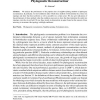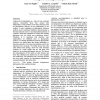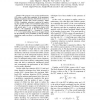83 search results - page 4 / 17 » Upper bounds on maximum likelihood for phylogenetic trees |
120
Voted
ICPP
2009
IEEE
15 years 7 months ago
2009
IEEE
—Recent advances in DNA sequencing techniques have led to an unprecedented accumulation and availability of molecular sequence data that needs to be analyzed. This data explosion...
87
Voted
IPPS
2006
IEEE
15 years 6 months ago
2006
IEEE
Inference of phylogenetic trees using the maximum likelihood (ML) method is NP-hard. Furthermore, the computation of the likelihood function for huge trees of more than 1,000 orga...
87
Voted
ALGORITHMICA
1999
15 years 15 days ago
1999
We analyze the performance of the popular class of neighbor-joining methods of phylogeny reconstruction. In particular, we find conditions under which these methods will determine ...
97
Voted
APBC
2004
15 years 2 months ago
2004
Undiscovered relationships in a data set may confound analyses, particularly those that assume data independence. Such problems occur when characters used for phylogenetic analyse...
103
click to vote
ICC
2008
IEEE
15 years 7 months ago
2008
IEEE
—We propose to use carrier interferometry (CI) codes to reduce the complexity of the maximumlikelihood multiuser-detection (ML-MUD) receiver in MC-CDMA systems with carrier frequ...



